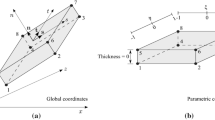Abstract
A finite element methodology for simulating the failure of high performance fiber reinforced concrete composites (HPFRC), with arbitrarily oriented short fibers, is presented. The composite material model is based on a micromorphic approach. Using the framework provided by this theory, the body configuration space is described through two kinematical descriptors. At the structural level, the displacement field represents the standard kinematical descriptor. Additionally, a morphological kinematical descriptor, the micromorphic field, is introduced. It describes the fiber–matrix relative displacement, or slipping mechanism of the bond, observed at the mesoscale level. In the first part of this paper, we summarize the model formulation of the micromorphic approach presented in a previous work by the authors. In the second part, and as the main contribution of the paper, we address specific issues related to the numerical aspects involved in the computational implementation of the model. The developed numerical procedure is based on a mixed finite element technique. The number of dofs per node changes according with the number of fiber bundles simulated in the composite. Then, a specific solution scheme is proposed to solve the variable number of unknowns in the discrete model. The HPFRC composite model takes into account the important effects produced by concrete fracture. A procedure for simulating quasi-brittle fracture is introduced into the model and is described in the paper. The present numerical methodology is assessed by simulating a selected set of experimental tests which proves its viability and accuracy to capture a number of mechanical phenomenon interacting at the macro- and mesoscale and leading to failure of HPFRC composites.





















Similar content being viewed by others
References
Bencardino F, Rizzuti L, Spadea G, Swamy RN (2010) Experimental evaluation of fiber reinforced concrete fracture properties. Composites B 41:17–24
Beyerlein IJ, Phoenix SL (1996) Stress concentrations around multiple fiber breaks in an elastic matrix with local yielding or debonding using quadratic influence superposition. J Mech Phys Solids 44:1997–2039
Capriz G (1989) Continua with microstructure. Springer, Berlin
Dias IM (2012) Strain injection techniques in numerical modeling of propagating material failure. PhD Thesis, Technical University of Catalunya, Barcelona
Dias IF, Oliver J, Huespe AE (2011) Strain injection, mixed formulations and strong discontinuities in fracture modeling of quasi-brittle materials. In: Proceedings of the congress on numerical methods in engineering 2011, Coimbra, Portugal, 14–17 June, 2011, pp 163–202. APMTAC, LIsbon
Frémond M, Nedjar B (1996) Damage, gradient of damage and principle of virtual power. Int J Solids Struct 33:1083–1103
Jiang H, Valdez JA, Zhu YT, Beyerlein IJ, Lowe TC (2000) The strength and toughness of cement reinforced with bone-shaped steel wires. Compos Sci Technol 60:1753–1761
Lee Y, Kang S, Kim JK (2010) Pullout behaviour of inclined steel fibers in an ultra-high strength cementitious matrix. Constr Build Mater 24:2030–2041
Li F, Li Z (2000) Continuum damage mechanics based modeling of fiber reinforced concrete in tension. Int J Solids Struct 36:777–793
Linero DL (2006) A model of material failure for reinforced concrete via Continuum Strong Discontinuity Approach and mixing theory. PhD Thesis, E.T.S. Enginyers de Camins, Canals i Ports, Technical University of Catalonia (UPC), Barcelona, 2006. CIMNE Monograph Number, M106
Mariano PM (2002) Multifield theories in mechanics of solids. Adv Appl Mech 38:1–93
Mariano PM, Stazi F (2005) Computational aspects of the mechanics of complex materials. Arch Comput Methods Eng 12:391–478
Oliver J (1989) A consistent characteristic length for smeared cracking models. Int J Numer Methods Eng 28:461–474
Oliver J, Huespe AE, Blanco S, Linero DL (2005) Stability and robustness issues in numerical modeling of material failure with the strong discontinuity approach. Comput Methods Appl Mech Eng 195(52):7093–7114
Oliver J, Huespe AE, Cante JC (2008a) An implicit/explicit integration schemes to increase computability of non-linear material and contact/friction problems. Comput Methods Appl Mech Eng 197:1865–1889
Oliver J, Linero DL, Huespe AE, Manzoli O (2008b) Two-dimensional modeling of material failure in reinforced concrete by means of a continuum strong discontinuity approach. Comput Methods Appl Mech Eng 197:332–348
Oliver J, Huespe AE, Cante JC, Diaz G (2010) On the numerical resolution of the discontinuous material bifurcation problem. Int J Numer Methods Eng 83:786–804
Oliver J, Mora D, Huespe AE (2012) A micromorphic model for steel fiber reinforced concrete. Int J Solids Struct 49:2990–3007
R. T. 162-TDF (2002) Recommendations of RILEM TC 162-TDF: test and design methods for steel fibre reinforced concrete: bending test. Mater Struct 35:579–582
Simo J, Hughes T (1998) Computational inelasticity. Springer, Berlin
Suwannakarn SW (2009) Post-cracking characteristics of high performance fiber reinforced cementitious composites. PhD Thesis, University of Michigan
Acknowledgments
The research leading to these results has received funding from the European Research Council under the European Union’s Seventh Framework Programme (FP/2007-2013) / ERC Grant Agreement n. 320815 (ERC Advanced Grant Project “Advanced tools for computational design of engineering materials” COMP-DES-MAT). The Spanish Ministry of Science and Innovation, and the Catalan Government Research Department, are also gratefully acknowledged for their financial support to this research under Grants BIA2011-24258 and 2009 SGR 1510, respectively.
Author information
Authors and Affiliations
Corresponding author
Rights and permissions
About this article
Cite this article
Huespe, A.E., Oliver, J. & Mora, D.F. Computational modeling of high performance steel fiber reinforced concrete using a micromorphic approach. Comput Mech 52, 1243–1264 (2013). https://doi.org/10.1007/s00466-013-0873-4
Received:
Accepted:
Published:
Issue Date:
DOI: https://doi.org/10.1007/s00466-013-0873-4




